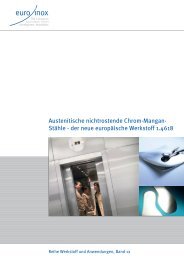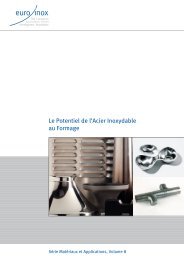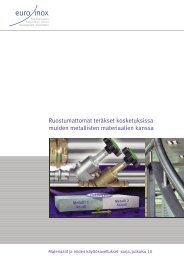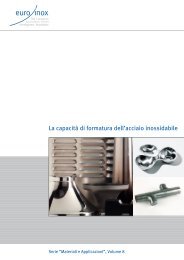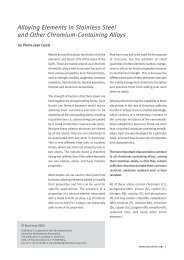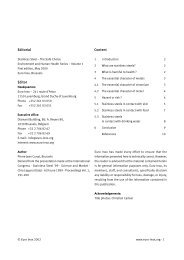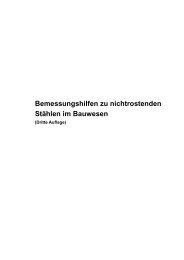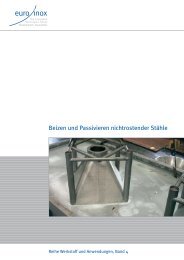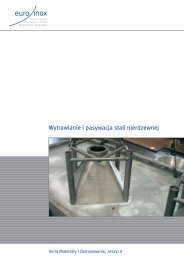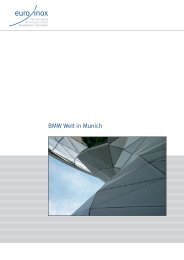Innovative Stainless Steel Applications in transport ... - Euro Inox
Innovative Stainless Steel Applications in transport ... - Euro Inox
Innovative Stainless Steel Applications in transport ... - Euro Inox
Create successful ePaper yourself
Turn your PDF publications into a flip-book with our unique Google optimized e-Paper software.
Weight reduction target<br />
10 %<br />
8 %<br />
5 %<br />
3 %<br />
Weight reduction that compensates high material costs (bus frames)<br />
(Fuel consuption 2 l/100 km per 1000 kg, no recycl<strong>in</strong>g credits)*<br />
75 000 km/year 100 000 km/year<br />
0 %<br />
6 years 10 years<br />
Operat<strong>in</strong>g lifetime<br />
15 years 20 years<br />
*(Discount rate 8%, fuel price 1.2 €/l w ith annual <strong>in</strong>crease of 5%, difference <strong>in</strong> material cost is 1 €/kg )<br />
Figure 72. Proportional weight sav<strong>in</strong>gs that offset a 1 € per kg higher material price <strong>in</strong> the life<br />
cycle fuel cost of bus components.<br />
These calculations demonstrate the importance of vehicle weight <strong>in</strong> bus <strong>transport</strong>ation.<br />
The same pr<strong>in</strong>ciple also applies to other road <strong>transport</strong> vehicles. The diesel consumption<br />
of trucks and other commercial vehicles also depends on the payload and, once aga<strong>in</strong>,<br />
weight sav<strong>in</strong>gs can be used to <strong>in</strong>crease payload or lower fuel consumption. In the case<br />
of heavy trucks, a vehicle weight sav<strong>in</strong>g of 1000 kg reduces fuel consumption by<br />
approximately 1 litre per 100 kilometres (Nylund 2006). This can be significant,<br />
because of ever longer driv<strong>in</strong>g distances and the cont<strong>in</strong>ued <strong>in</strong>crease <strong>in</strong> freight <strong>transport</strong><br />
by road. In typical service conditions, the potentially higher <strong>in</strong>itial cost of us<strong>in</strong>g<br />
sta<strong>in</strong>less steel, compared with carbon steel, is largely offset by the effect of the result<strong>in</strong>g<br />
weight sav<strong>in</strong>g on fuel consumption.<br />
Although they go beyond the scope of this study, the follow<strong>in</strong>g factors, which have a<br />
further <strong>in</strong>fluence on life cycle cost, should be addressed:<br />
• In contrast to carbon steel, where metallic and organic coat<strong>in</strong>gs and pa<strong>in</strong>t<strong>in</strong>g<br />
provide corrosion protection, with sta<strong>in</strong>less steel, these essentially have only a<br />
decorative function. The number of layers can therefore be reduced and the<br />
overall structure of the coat<strong>in</strong>g simplified. Because of sta<strong>in</strong>less steel’s <strong>in</strong>tr<strong>in</strong>sic<br />
corrosion resistance, corrosion-related repair costs can be expected to be lower.<br />
• Accidental damage or wear and tear that locally weaken or remove the corrosion<br />
protection on carbon steel have no effect of the <strong>in</strong>tr<strong>in</strong>sic corrosion resistance of<br />
sta<strong>in</strong>less steel. Even if damage should lead to localised discolouration<br />
114



